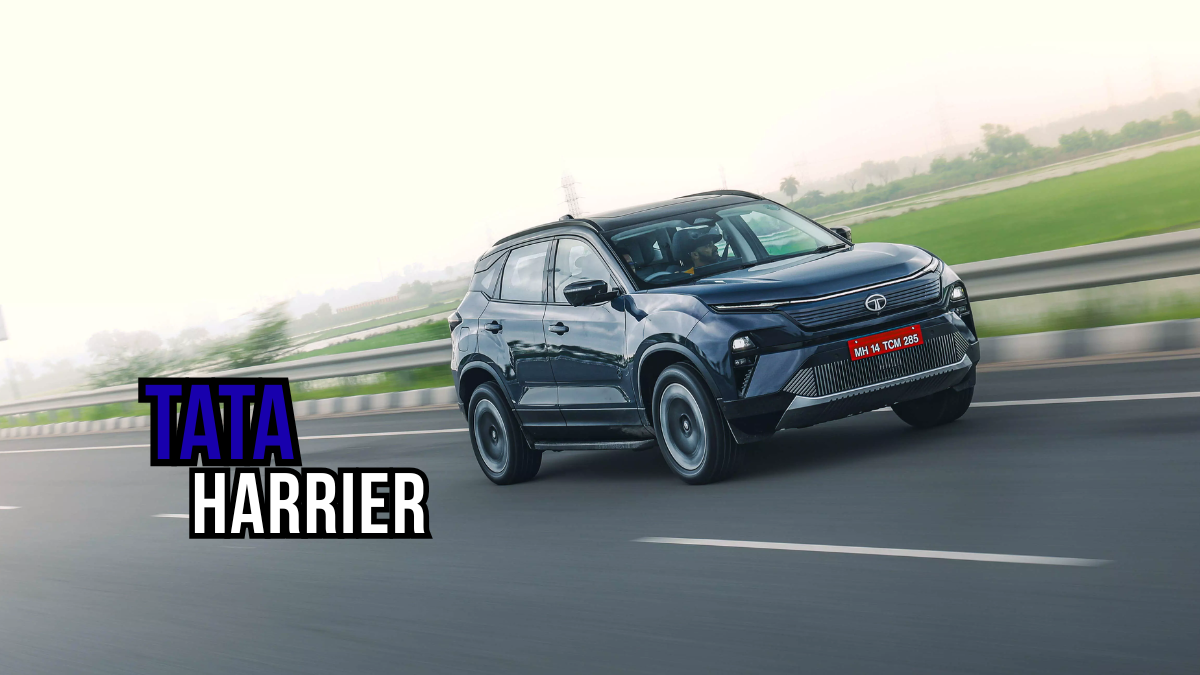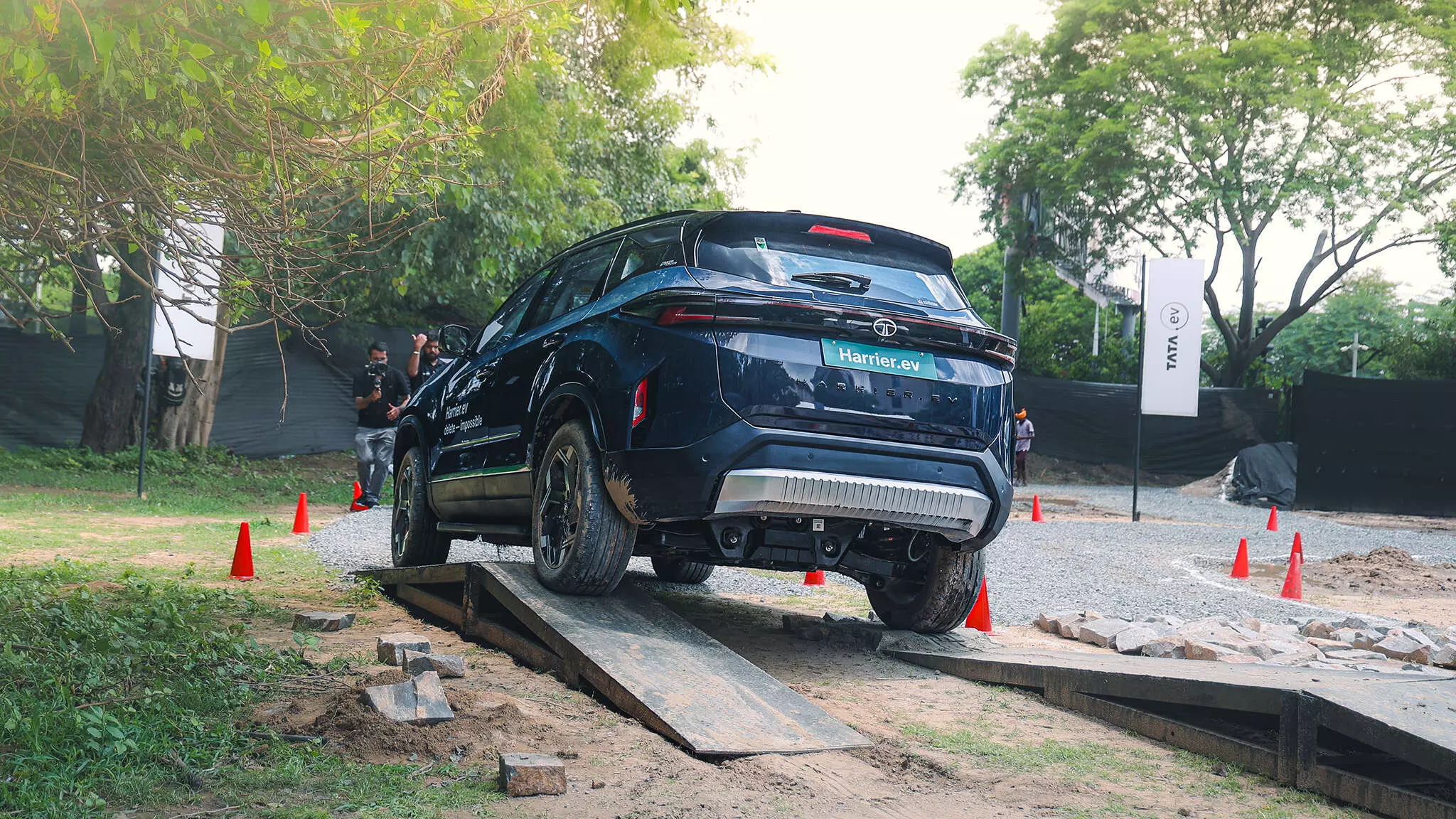The electric vehicle revolution has arrived in India’s premium SUV segment, and Tata Motors is leading the charge with their flagship Harrier EV. After months of anticipation and social media buzz, we finally got behind the wheel of what many are calling India’s most compelling electric SUV. But does it live up to the hype?

The Tata Harrier EV represents more than just another ICE-to-electric conversion. It’s Tata’s bold statement in the premium electric SUV space, complete with cutting-edge technology, all-wheel drive capability, and the promise of combining rugged Indian road capability with zero-emission driving. With rivals like the Mahindra XEV 9e and MG Windsor making waves, the question isn’t just whether the Harrier EV is good it’s whether it’s good enough to dominate this rapidly evolving segment.
Design That Commands Respect
The Harrier EV strikes an impressive balance between familiar and futuristic. Unlike some competitors that have gone full sci-fi, Tata has wisely retained the Harrier’s commanding road presence while adding thoughtful EV-specific touches.
Up front, the closed-off grille features horizontal design lines and strategic air vents for aerodynamic efficiency. The connected LED light bar serves as a daytime running light, creating a distinctive signature that’s impossible to miss. The 19-inch aero-optimized alloy wheels not only look stunning but also contribute to the vehicle’s impressive range figures.
What really sets the Harrier EV apart from its ICE sibling are the subtle details. The ‘QWD Dual Motor’ badge on the C-pillar hints at its all-wheel drive capability, while EV-specific badging keeps the look clean and modern. At 4,607mm long, 2,232mm wide, and 1,740mm tall, it maintains the imposing stature that made the original Harrier so popular.
The rear features connected LED taillights with signature startup and shutdown animations. Our test vehicle came in the striking Nocturne Nainital color a chameleon-like finish that shifts between blue and purple depending on lighting conditions.
Interior Technology That Impresses
Step inside the Harrier EV, and you’re immediately struck by the premium cabin atmosphere. The standout feature is the massive 14.53-inch Samsung Neo QLED touchscreen a segment-first that delivers stunning visual quality with deep blacks and high contrast, just like a premium Samsung TV.
The infotainment system is packed with intelligent features. The smart range map doesn’t just show remaining kilometers it visually displays the area you can cover, creating a geofence-like experience. DrivePay acts as a digital wallet, allowing seamless payment for EV charging and FASTag tolls directly through the system.
The digital instrument cluster provides comprehensive information, including live feeds from blind spot cameras. Perhaps the most impressive tech feature is the digital IRVM (interior rearview mirror), which streams footage from a camera mounted on the shark-fin antenna. This system can record front and rear footage simultaneously and maintains clear rear visibility even when the boot is fully loaded.
The 360-degree camera system includes a transparent bonnet view extremely useful for off-road adventures or tight urban maneuvering. Other premium touches include phygital climate controls, a cooled center armrest, powered and ventilated front seats, and a 10-speaker JBL system with Dolby Atmos support.
Powertrain Performance That Delivers
The Harrier EV comes with two battery options: 65kWh and 75kWh. Our test vehicle featured the larger 75kWh pack with the QWD (Quad Wheel Drive) system making it the only mainstream Indian EV with dual-motor all-wheel drive.
The numbers are impressive: the front motor produces 158 horsepower, while the rear motor delivers 238 horsepower. Combined peak torque reaches 504 Nm, enabling a 0-100 kmph sprint in just 6.3 seconds, making it one of the quickest Indian EVs available.
The claimed range of 622 kilometers (MIDC cycle) translates to approximately 450-490 kilometers in real-world conditions. During our test drive starting at 100% charge with 492km indicated range, we ended with 59% battery and 240km remaining, suggesting the real-world estimates are quite realistic.
Drive Modes and Terrain Capability
The Harrier EV offers four drive modes: Eco, City, Sport, and Boost (available only on QWD variants). Each mode has a distinctly different character. Eco prioritizes efficiency without making the vehicle feel sluggish, while City mode provides the best balance of performance and range for daily driving.
Sport mode awakens the dual-motor setup’s full potential, delivering addictive acceleration that makes highway overtaking effortless. Boost mode provides an extra surge of power for brief periods, creating that pin-you-to-your-seat sensation that makes electric driving so thrilling.
The terrain management system offers six modes: Normal, Snow/Grass, Mud-Ruts, Sand, Rock Crawl, and Custom. The Custom mode is particularly clever, allowing drivers to fine-tune specific parameters for unique conditions. There’s even a Drift Mode that shifts power bias to the rear motor for a more engaging driving experience on loose surfaces.
Ride Quality and Handling
Despite weighing over 2.3 tonnes, the Harrier EV feels remarkably composed on the road. The all-independent suspension with frequency-dependent dampers strikes an excellent balance between comfort and control. The ride quality is genuinely impressive, potholes and speed bumps are absorbed with remarkable composure, while highway cruising remains smooth and stable.
The electric power-assisted steering is light at low speeds and gains appropriate weight as speeds increase. While it’s not sports car sharp, it provides adequate feedback for confident driving. Body roll is well-controlled for such a large SUV, and the all-disc brake setup provides strong, progressive stopping power.
The regenerative braking system offers four levels of adjustment via paddle shifters, with the third level providing near single-pedal driving capability. However, the system is tuned more for smoothness than maximum energy recovery.
Charging and Practicality
The 75kWh battery supports DC fast charging up to 120kW, enabling 20-80% charging in approximately 25 minutes. The 7.2kW AC charger takes about 10.7 hours for a complete charge. The vehicle also supports Vehicle-to-Load (V2L) and Vehicle-to-Vehicle (V2V) charging capabilities.
Interior space is generous for five passengers, with flat floors thanks to the under-floor battery placement. The “Boss Mode” feature allows rear passengers to electrically adjust the front passenger seat for additional legroom. The 502-liter boot (expandable to 999 liters with rear seats folded) provides adequate cargo space, though the raised loading floor due to the spare tire placement can make loading heavy luggage slightly challenging.
What Could Be Better

While the Harrier EV impresses in most areas, there are some concerns worth noting. The all-white interior on the top Empowered trim, while striking, may not age well in India’s dusty conditions. Some electronic features, including the connectivity app and certain automated functions, were still in development during our test drive.
The ADAS system, while comprehensive, can feel overly intrusive on India’s chaotic roads and may require frequent manual override. Additionally, some reviewers noted occasional glitches with features like the tailgate button and window auto-down function.
Pricing and Value Proposition
Starting at Rs 21.49 lakh (ex-showroom) for the base Adventure trim, the Harrier EV is competitively priced against both its ICE sibling and electric rivals. The top QWD variant at Rs 30.23 lakh represents significant value when you consider the dual-motor setup, advanced features, and impressive range.
When compared to rivals like the Mahindra XEV 9e (Rs 21.90-31.25 lakh) and BE 6 (Rs 18.90-27.65 lakh), the Harrier EV holds its own while offering the mature, proven platform that many buyers prefer.
The Electric Future Looks Promising
The Tata Harrier EV successfully bridges the gap between traditional SUV appeal and electric vehicle innovation. It retains the commanding presence and rugged capability that made the original Harrier popular while adding the instant torque, silent operation, and environmental benefits that make electric vehicles so compelling.
The QWD system transforms the Harrier EV from a capable family SUV into a serious off-road performer, while the impressive range figures address one of the biggest concerns about electric vehicle ownership. The extensive feature list and premium cabin make it feel like a genuine luxury offering rather than a compromise.
For buyers seeking a no-nonsense electric SUV that doesn’t sacrifice capability for efficiency, the Harrier EV presents a compelling case. It’s not just another electric conversion, it’s a thoughtful reimagining of what an Indian electric SUV should be.
The Harrier EV proves that the hype surrounding its launch was justified. Tata Motors has created an electric SUV that doesn’t just meet expectations, it exceeds them. As India’s electric vehicle market continues to evolve, the Harrier EV stands as proof that domestic manufacturers can compete with the best in the world.
FAQs About TATA Harrier EV
1. What is the range of the Tata Harrier EV?
The Tata Harrier EV is expected to deliver an impressive range of approximately 400-500 km on a single charge, depending on driving conditions and usage.
2. What charging options are available for the Harrier EV?
The Harrier EV supports both AC and DC fast charging. While a standard AC charger offers overnight charging capabilities, the DC fast charger can significantly reduce charging time, providing a quick top-up for long journeys.
3. What makes the Harrier EV stand out among other electric SUVs?
The Harrier EV combines a bold design, advanced features, and Tata Motors’ proven reliability to make it a compelling choice. Its spacious cabin, cutting-edge technology, and competitive pricing further enhance its appeal in the electric SUV market.
4. Is the Tata Harrier EV suitable for off-road use?
Yes, the Harrier EV is designed with rugged terrains in mind. With robust build quality, a powerful electric drivetrain, and excellent ground clearance, it is well-suited for both urban roads and adventurous off-road trails.
5. When will the Tata Harrier EV be launched in India?
Tata Motors plans to launch the Harrier EV in the Indian market soon, with an official release date expected to be announced in the coming months. Stay tuned for updates!
For More Information Click HERE
